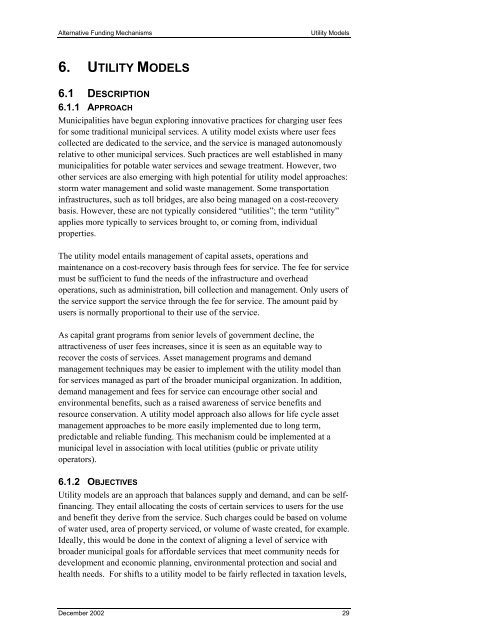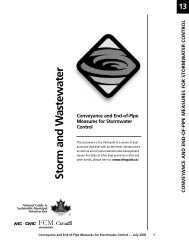ALTERNATIVE FUNDING MECHANISMS - FCM
ALTERNATIVE FUNDING MECHANISMS - FCM
ALTERNATIVE FUNDING MECHANISMS - FCM
You also want an ePaper? Increase the reach of your titles
YUMPU automatically turns print PDFs into web optimized ePapers that Google loves.
Alternative Funding Mechanisms Utility Models<br />
6. UTILITY MODELS<br />
6.1 DESCRIPTION<br />
6.1.1 APPROACH<br />
Municipalities have begun exploring innovative practices for charging user fees<br />
for some traditional municipal services. A utility model exists where user fees<br />
collected are dedicated to the service, and the service is managed autonomously<br />
relative to other municipal services. Such practices are well established in many<br />
municipalities for potable water services and sewage treatment. However, two<br />
other services are also emerging with high potential for utility model approaches:<br />
storm water management and solid waste management. Some transportation<br />
infrastructures, such as toll bridges, are also being managed on a cost-recovery<br />
basis. However, these are not typically considered “utilities”; the term “utility”<br />
applies more typically to services brought to, or coming from, individual<br />
properties.<br />
The utility model entails management of capital assets, operations and<br />
maintenance on a cost-recovery basis through fees for service. The fee for service<br />
must be sufficient to fund the needs of the infrastructure and overhead<br />
operations, such as administration, bill collection and management. Only users of<br />
the service support the service through the fee for service. The amount paid by<br />
users is normally proportional to their use of the service.<br />
As capital grant programs from senior levels of government decline, the<br />
attractiveness of user fees increases, since it is seen as an equitable way to<br />
recover the costs of services. Asset management programs and demand<br />
management techniques may be easier to implement with the utility model than<br />
for services managed as part of the broader municipal organization. In addition,<br />
demand management and fees for service can encourage other social and<br />
environmental benefits, such as a raised awareness of service benefits and<br />
resource conservation. A utility model approach also allows for life cycle asset<br />
management approaches to be more easily implemented due to long term,<br />
predictable and reliable funding. This mechanism could be implemented at a<br />
municipal level in association with local utilities (public or private utility<br />
operators).<br />
6.1.2 OBJECTIVES<br />
Utility models are an approach that balances supply and demand, and can be selffinancing.<br />
They entail allocating the costs of certain services to users for the use<br />
and benefit they derive from the service. Such charges could be based on volume<br />
of water used, area of property serviced, or volume of waste created, for example.<br />
Ideally, this would be done in the context of aligning a level of service with<br />
broader municipal goals for affordable services that meet community needs for<br />
development and economic planning, environmental protection and social and<br />
health needs. For shifts to a utility model to be fairly reflected in taxation levels,<br />
December 2002 29
















